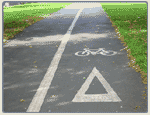
Taxonomy and description
Terminology
Technology
 Terminology Terminology
Cycle routes provide dedicated infrastructure for cyclists intended to
separate cyclists physically from motorised traffic, and hence differ
from Cycle lanes, located close to the carriageway and separated by markings
or kerbstones, cf. section 4.3.a.
Cycle routes can be defined at two different levels:
- Cycle tracks or paths as dedicated single stretches psychically separated
from the carriageway (by verges, vegetation or the like) and often located
at a certain distance from the carriageway. Physical separation can
also be achieved vertically by constructing the cycle route as pavements
at a higher level than the traffic lane (paving tracks), but this is
not a common solution. Cycle routes are often located at one side of
the road and can be used in both directions, but they can also be one-way
tracks. Cycle routes as stretches have to be complemented by managerial
cycle priorities at junctions.
- Cycle routes as a network throughout the city that includes dedicated
infrastructure both alongside the roads and at the intersections with
vehicle traffic. At intersections cycle routes in this sense should
preferably include infrastructure measures like cycle tunnels or bridges.
Mostly cycle route networks also include different managerial measures
like cycle lanes and priorities.
 Routes
for cyclists at both levels may be combined with routes for pedestrians.
Paths or tracks for walking and cycling are dedicated roads for pedestrians
and cycles used in the Nordic countries. Foot and cycle tracks are usually
constructed on one side of the road only and will have traffic in both
directions. To mix pedestrians and cyclists is only recommended on stretches
with few pedestrians, or as a second best solution where space is scarce. Routes
for cyclists at both levels may be combined with routes for pedestrians.
Paths or tracks for walking and cycling are dedicated roads for pedestrians
and cycles used in the Nordic countries. Foot and cycle tracks are usually
constructed on one side of the road only and will have traffic in both
directions. To mix pedestrians and cyclists is only recommended on stretches
with few pedestrians, or as a second best solution where space is scarce.
Recommended widths are:
- Cycle routes, tracks for cyclists only: 1.8 – 2.0 metres
- Tracks for walking and cycling: 3.0 metres
When planning for cycling, one must take the different type of cyclists
and trip destinations into account, cf. table 3. To be used cycle routes
must be properly maintained. Gravel and ice on the surface may bring
cyclists to prefer the vehicle roads to the cycle routes.
Cycle routes as stretches or piecemeal measures can achieve significant
savings in cycle accidents, but in order to attract more people to cycle
a comprehensive cycle route network solution is required rather than piecemeal
measures. Other cycle measures for combination or inclusion in a network
may be:

Several other infrastructure as well as management measures; like road
maintenance, traffic calming and speed regulation will make it safer and
attract more people to cycle as well. Combination with other transport
measures intending to reduce car trips are recommended.
insert picture
Figure 1: Separated on-way separated cycle track/route in Genk in Belgium.
Source: Adonis (1998). Copyright ã has to be achieved
Technology
Cycle routes require different technologies, most important is road building
technology and special design for cycle routes, tracks, tunnels and bridges.
Road design guidelines in many countries can give detailed information
on the technology needed.
The report from the EU project ADONIS (1998) contains a catalogue on
CD ROM with detailed descriptions of 60 cycle measures where technology,
design and requirements etc. are treated. This catalogue is recommended
for details. (ADONIS = Analysis and Development Of New Insight to Substitution
of short car trips by cycling and walking.)
Insert picture

|




